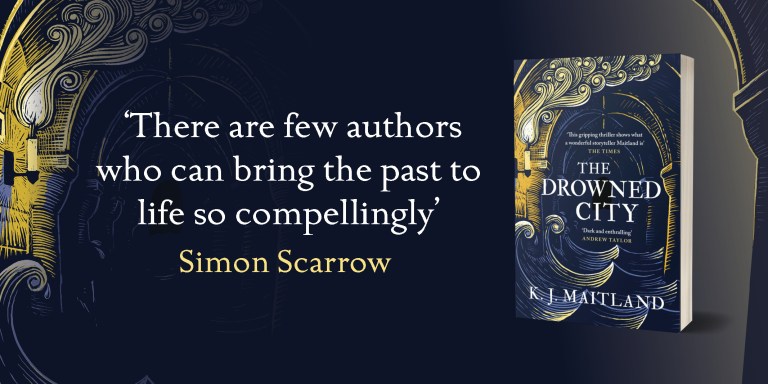Witchcraft and the Bristol Tsunami – K . J. Maitland

Maundy Thursday in Sweden was thought to be the day when witches stole brooms and livestock and used them to fly through the night sky to the legendary island of Blåkulla where the Devil held court. This belief probably stems from the Christian tradition that the Thursday before Easter was the day on which Judas betrayed Jesus, an act which was said to have released all the forces of evil into the world. On this day, Swedish villagers would hide their brooms and hang charms around the necks of their animals to prevent the witches using them in their wild rides. They lit bonfires to stop witches landing, or left gifts of food and drink outside, so that they wouldn’t cause misfortune and mischief.
In Britain and throughout Europe, witches were credited with the ability to conjure up destructive winds and storms, which is one the reasons they were so feared. Although, sailors bought knotted cords from witches, so that if they were becalmed at sea, they could unknot the cord to release the winds. King James VI of Scotland became convinced that the sea storm in 1589 which had nearly drowned his Danish bride-to-be, Anne, and the subsequent storm which had almost stopped James from reaching Norway to marry her, had both been conjured by witchcraft. His belief was confirmed at the trial of North Berwick witches in 1590, when Agnes Simpson was tortured into confessing that she and some ninety women had raised the storm to try to sink the King’s ship in a bizarre ritual which involved tying a ‘baptised’ cat to the limbs of human corpse which they cast into the sea.
King James, no doubt, had these events in mind when in 1597 he wrote in his book, Daemonologie, that witches ‘can raise storms and tempests in the air, either upon sea or land … which likewise is very easy to be discerned from any other natural tempests … in respect of the sudden and violent raising thereof, together with the short enduring of the same.’
And sudden and violent were the very words people used to describe what happened on calm, clear morning in late January 1606. Coming apparently out of nowhere, a giant wave roared up the Bristol Channel, devastating the low-lying regions of Devon, Somerset, Gloucestershire and South Wales. It swept inland as far as Glastonbury Tor, 14 miles from the coast, destroying whole villages and leaving 2,000 people dead or missing. The Welsh coast was hit even harder than the English side, particularly the town of Cardiff. Eyewitnesses claimed the wave travelled ‘with a swiftness so incredible, that no greyhound could have escaped by running before it.’ Contemporary accounts describe the wave as a ‘dazzling mountain’ that seemed to be on fire with a cloud of smoke and sparks around it. No wonder that many stood and stared, unable to comprehend what was rushing towards them until it was too late.
As news of this disaster spread, people struggled to understand what had happened. Some claimed it was an ‘Act of God’, divine judgement against the kingdom, for it was the anniversary of the brutal execution of the first of the gunpowder plotters, some of whom their supporters whispered, were innocent. But others were certain this was the Devil’s work, a wave conjured by witchcraft. One pamphlet which circulated widely in London claimed that bells had rung in church towers in the middle of the night before the wave struck, but those who went to investigate found no one inside and after the wave struck, they became convinced it was the ghostly hands of the dead ringing those bells summoning the living to join them. But many took it as proof that witches had been flying through the night sky to conjure this diabolical wave, alighting on church roofs and striking the bells as they careered past in their wild ride.
The cause of the flood has been widely debated in recent years. Theories range from a storm surge to a tsunami produced by an underwater landslide off Cornwall or an earthquake under the sea near Ireland. It was noted at the time, that the sea receded a considerable distance before a wall of water surged back, which is consistent with a tsunami. And many of the details which were reported in the broadsheets and pamphlets written soon after are remarkably similar to those given by modern eyewitnesses to recent tsunamis. The ringing of the bells might indicate earth tremors which would be a precursor to a tsunami. Although, that detail could have been an ‘omen’ added in hindsight by the author of the pamphlet, since some diarists record experiencing earth tremors several months later, in May, which caused bells to ring. Certainly, some writers of these pamphlets were keen to show this terrible flood was Devil’s work and witchcraft was behind this.
And in my novel The Drowned City, when Daniel Pursglove first sees the terrible devastation in Bristol caused by the great wave, he is almost tempted to believe it is the devil’s work, but Daniel soon realises it not witchcraft the townspeople should fear, but those taking advantage of this death and destruction for their own sinister ends.
**Longlisted for the CWA Historical Dagger Award**
'A gripping thriller' THE TIMES | 'Dark and enthralling' ANDREW TAYLOR | 'Devilishly good' DAILY MAIL
'I couldn't put it down' ⭐ ⭐ ⭐ ⭐ ⭐
'A story of disaster, espionage, murder and a deep-seated conspiracy... it's nothing short of genius' ⭐ ⭐ ⭐ ⭐ ⭐
Revenge runs deep in this captivating historical thriller for fans of C.J. Sansom and Laura Shepherd-Robinson.
1606. England stands divided in the wake of the failed Gunpowder Plot. As a devastating tidal wave sweeps the Bristol Channel, rumours of new treachery reach the King.
In Newgate prison, Daniel Pursglove receives an unexpected - and dangerous - offer. Charles FitzAlan, close confidant of King James, will grant his freedom - if Daniel can infiltrate the underground Catholic network in Bristol and unmask the one conspirator still at large.
Where better to hide a traitor than in the chaos of a drowned city? Daniel goes to Bristol to investigate, but soon finds himself at the heart of a dark Jesuit conspiracy - and in pursuit of a killer.
PRAISE FOR DANIEL PURSGLOVE BOOK 1
'Colourful and compelling' SUNDAY TIMES
'Goes right to the heart of the Jacobean court' TRACY BORMAN
'Spies, thieves, murderers and King James I? Brilliant' CONN IGGULDEN
'The intrigues of Jacobean court politics simmer beneath the surface in this gripping and masterful crime novel' KATHERINE CLEMENTS
'Shadows and menace lurk round almost every corner... Brilliant writing and more importantly, riveting reading' SIMON SCARROW
'Beautifully written with a dark heart, Maitland knows how to pull you deep into the early Jacobean period' RHIANNON WARD







